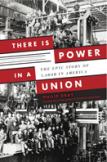Getting Organized
This unusually interesting book delivers on the promise of its subtitle. It tells the truly epic story of labor in America from the early 19th-century textile workers in the nation’s first industrial city, Lowell, Mass., to the November 1999 protests when the World Trade Organization met in Seattle. As Andy Stern, then president of the Service Workers International Union, observed amid the Seattle discontent, “Trade is global, capital is global, and labor too must become global.” But, as the award-winning author and historian Philip Dray asks toward the end of this very long story, “How would one begin to write some sort of global Wagner Act, an international baseline of workers’ rights, let alone enact and enforce it?”
Senator Robert F. Wagner is one of the names Dray lists on the last page of this book by way of rounding up the leading figures in the movement he chronicles so effectively. The list includes Eugene Debs, Mother Jones, Joseph Ettor, John Reed, Big Bill Haywood, Elizabeth Gurley Flynn, Carlo Tresca, Joe Hill, John L. Lewis, Jimmy Hoffa, George Meany and Walter Reuther.
The Molly Maguires and the Haymarket martyrs along with Triangle Shirtwaist and place names like Lynn and Lawrence in Massachusetts, Homestead in Pennsylvania, Pullman in Illinois, Trinidad in Colorado, the New York City waterfront and the farm fields of California also figure prominently in Dray’s narrative.
Franklin D. Roosevelt (whom Saul Alinsky saw as “an aristocrat with an intellectual sympathy for labor”) and his New Deal secretary of labor Frances Perkins (she thought the department should be called the “Department for Labor”) are likewise integral to this history.
An investment of several hours a day for a week or more will reward the interested reader with the context needed to interpret past economic, social and cultural trends in the United States, as well as a useful range finder to view the future. Dray is gentle in posing the challenge. He is not optimistic about the state of organized labor. Nor is he optimistic about the future, although he is an unapologetic admirer of what organized labor has done to protect human dignity and promote justice in the American workplace.
Sobering statistics enliven the record Dray provides. He notes the toll of workplace suffering that “has always been something of a hidden detail of the American work experience.” He cites the years 1880-1910, when as many as 10 thousand to 15 thousand American workers a year died in on-site accidents, not to mention the thousands more who were injured or sickened, mostly in mining and railroad work.
Readers will appreciate the author’s clarifications of many familiar but not necessarily fully understood aspects in the labor narrative. For instance, in its original usage with reference to the garment industry, sweatshop “was not a reference to the temperature in the workplace (although in summer that may have been appropriate) but rather the management practice of ‘sweating’ labor.” This meant assigning specific jobs on lots of garments to ever-smaller shops or units within the same factory. It also meant that manufacturing costs were “sweated” downward, to lower-level shop owners and floor supervisors. The workers themselves had to negotiate and renegotiate wages and production deadlines. This left many workers vulnerable and with little or no job security.
Similarly, the famous response of Samuel Gompers to the question “What does labor want?” was not a monosyllabic (and dollar-focused) more, as many of us have long believed. Dray provides a fuller statement first published in 1893: “What does labor want? It wants the earth and the fullness thereof.... Labor wants more schoolhouses and less jail cells; more books and less arsenals; more learning and less vice; more leisure and less greed; more justice and less revenge; in fact, more of the opportunities to cultivate our better natures, and to make mankind more noble, womanhood more beautiful, and childhood more happy and bright.”
Dray is fair but tough in assessing events associated with President Ronald Reagan’s decision to fire 11,000 federal air traffic controllers in 1981 for failure to follow his order to return to work. This destroyed the union. In Dray’s words, Reagan “turned his back on eight decades of labor progress, by whatever name it had ever aspired to be known, from industrial democracy to collective bargaining.”
I would have been happy to see reference made to the Jesuit-run labor schools that sprang up on the East coast in the late 1930s and early ‘40s. They educated union members in the exercise of their newly acquired rights under the Wagner Act. Mention is made, however, of the film “On the Waterfront,” in which Karl Malden portrays John “Pete” Corridan, S.J., who organized longshoremen against corruption on the New York and Jersey City docks.
Teachers’ unions are also overlooked in Dray’s account. To be fair, though, no single book can cover everything, and this one comes closer than any other I have read to offering a balanced and comprehensive coverage of a force for American progress that is now in danger of becoming a relic of our storied past.
This article also appeared in print, under the headline “Getting Organized,” in the February 21, 2011, issue.








